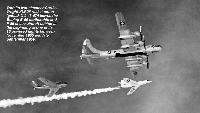Фотографии
-
Самолет NB-52A «Мячик-3» выполняет сброс гиперзвукового ракетоплана X-15 - полигон Роджерс Дрю Лейк в пустыне Мохаве в Калифорнии, 1959 г.
With the rocket powerplant yet to be ignited, the first X-15, 56-6670, is launched from the NB-52 mothership early in the test programme.Самолёты на фотографии: Boeing B-52 Stratofortress - США - 1955North American X-15 - США - 1959
-
Регистрационный номер: XK526 [2] Макет палубы авианосца и катапульты в НИЦ авиации Великобритании в Бедфорде сыграли важную роль в программе Buccaneer. На снимке - первый S.Mk 2 во время испытаний, он вооружен блоками из 24 ракет (на вооружение не приняты).
During the summer of 1964 the Blackburn Buccaneer S.2 prototype XK526 was used extensively for “Minimum Launching Trials” at the Royal Aircraft Establishment at Bedford. Geoff Higgs, soon to become head of the A&AEE’s Naval Test Squadron, made a catapult take-off from the dummy deck at Bedford on August 25, 1964.Самолёты на фотографии: Blackburn Buccaneer / B-103 - Великобритания - 1958
-
Регистрационный номер: XK526 [2] Buccaneer S.2 XK526 during a dummy deck take-off at RAE Bedford.
Самолёты на фотографии: Blackburn Buccaneer / B-103 - Великобритания - 1958
-
Регистрационный номер: XN974 Geoff Higgs in the front seat of one of the three Buccaneer S.2s sent to the USA for trials aboard the USS Lexington in 1965. On October 4 that year Higgs and Lt-Cdr A. Taylor returned to the UK in S.2 XN974, flying from Goose Bay to Lossiemouth without refuelling to complete the first non-stop crossing of the Atlantic by an FAA aircraft.
Самолёты на фотографии: Blackburn Buccaneer / B-103 - Великобритания - 1958
-
Geoff Higgs beside the F-4 Phantom in which he deliberately flew into raging thunderstorms in 1974 while participating in Operation Da Yu, a series of flight trials in Singapore to evaluate rain-erosion for the Concorde test programme, a task he likened to “taking the family saloon at high speed over a tank range”.
Самолёты на фотографии: McDonnell Douglas F-4 Phantom II - США - 1958
-
With its two-chamber Curtiss-Wright XLR25 rocket motor ignited, X-2 46-674 leaves the Boeing B-50 mothership and F-86 chase aircraft behind at the beginning of one of its 13 powered flight between November 1955 and late September 1956.
Самолёты на фотографии: Bell X-2 - США - 1952Boeing B-50 Superfortress - США - 1947North American F-86 Sabre - США - 1947
-
Captain Iven C. Kincheloe Jr in the cockpit of an F-104. “Kinch”, a born pilot, made his first solo flight on his 16th birthday and famously went on to be hailed as “America’s first spaceman”, despite the epithet being technically untrue.
Самолёты на фотографии: Lockheed F-104 Starfighter - США - 1954
-
Bell X-2 serial 46-674 at Edwards Air Force Base in California. Although the first sequentially of the two built, it was actually completed after 46-675, and was the example in which Kincheloe made his first flight in the type in May 1956, when he reached a comparatively sedate Mach 1-14 at 46,000ft (14,000m).
Самолёты на фотографии: Bell X-2 - США - 1952
-
Kinch (far right) poses with Edwards Flight Test Director Col Horace Hanes (centre) and fellow X-2 pilot Capt Milburn “Mel” Apt, who would be killed a matter of days later when X-2 46-674 suffered inertia-coupling during a flight and the ejection capsule malfunctioned.
Самолёты на фотографии: Bell X-2 - США - 1952
-
Three X-15s were built, the others being '671 and '672, the latter being the example in which John McKay (seen with the aircraft) reached Mach 5-33 and an altitude of 295,600ft (90,100m) on September 28, 1965, with Geoff Higgs observing in an F-104B. nasax2
Самолёты на фотографии: North American X-15 - США - 1959
-
For some time before the end of the X-2 programme, plans had been in place for the development of an even more extraordinary aircraft for hypersonic and very-high-altitude research; the result being North American’s remarkable X-15, three examples of which were built. Seen here is the first, 56-6670, on the lakebed at Edwards.
Самолёты на фотографии: North American X-15 - США - 1959
-
The third North American X-15, 56-6672, streaks away from F-104B chase aircraft 57-1301 on September 28, 1965.
Самолёты на фотографии: Lockheed F-104B / F-104D/ TF-104G - США - 1957North American X-15 - США - 1959
-
Регистрационный номер: XD212 On its introduction into service in the summer of 1957, the Supermarine Scimitar became the largest, heaviest and most powerful fighter the Fleet Air Arm had acquired up to that time. Its twin Rolls-Royce Avon engines of some 10,000Ib-thrust each also made it the noisiest. Seen here is first production Scimitar F.1 XD212.
Самолёты на фотографии: Supermarine Scimitar - Великобритания - 1956
-
Missile with two men in it - F-104B 57-1301, the two-seat Starfighter in which Geoff Higgs flew in the back seat for his X-15 chase flight on September 28, 1965.
Самолёты на фотографии: Lockheed F-104B / F-104D/ TF-104G - США - 1957
Статьи
- -
- B.Gardner - Foxable Four
- G.Ellis - Brothers in Arms
- J.Franzi - Smile Please...! /An eye for detail/
- J.Stroud - The Finnish Line /The John Stroud Archive/
- M.Nelson - A Model Prisoner
- M.Willis, D.Armson - "A snowflake settling on the water..."
- N.Follett - Ron Flockhart's Pony Express
- N.Stroud - The Magnificient 7
- P.Davidson - Off the Beaten Track...
- P.Jarrett - Lost & Found
- P.Jarrett - Mr. Cody & Mr. Roe (2)
- R.White - The New Frontier
- S.Aloni - The Pick-up Artist
- T.Jones - Air International Affair













